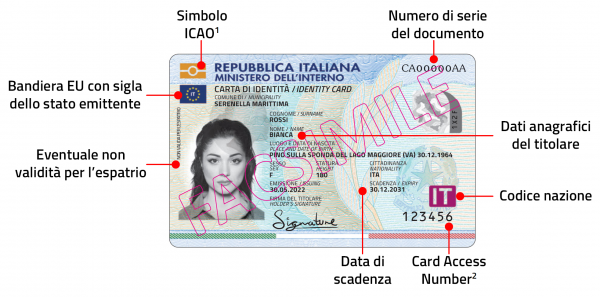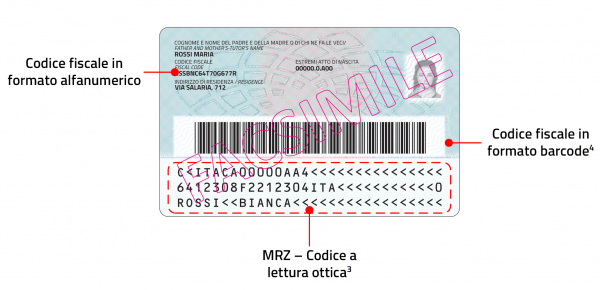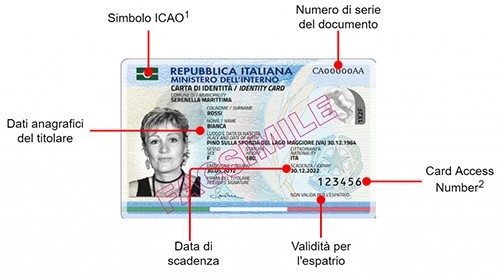The CIE is the evolution of the paper – based identity card. It measures the size of a credit card (85.60mm wide by 53.98mm high) and consists of a support of polycarbonate plastic material, on which the photo and data of the citizen are laser printed, protected with anti-counterfeiting elements such as holograms and special inks;
The CIE is equipped with a contactless microchip with:
- Personal data, photo and fingerprints of the owner, protected by a mechanism that avoid any possibility of counterfeiting or improper reading;
- Information to authenticate citizens to online services provided by public administrations;
- further data for the use of value-added services, in Italy and Europe;
CIE layout
The front of the identity cards produced from 29 September 2022 is enriched by the insertion of the European Union flag and a security element containing the initials IT nation.
Identity cards issued previously continue to be valid until their natural expiry.
1. The symbol marks the presence of a contactless microchip complying with the international reference standard for electronic travel documents, such as a passport
2. Numerical code used by the supervisory authorities to read the data stored in the microchip
3. The code allows to read, decode and verify the information stored in the document through the use of an optical character reader (OCR)
4. Tax code readable by optical scanner
Each CIE contains a serial number printed on the front in the top right-hand corner opposite to the photo Each CIE bears the serial number of the Electronic Identity Card in the top right corner, on the opposite side of the photograph. The serial number of the CIE is composed of a different sequence from that of the paper identity card: 2 letters – 5 numbers – 2 letters.
In the example figure, the serial number corresponds to CA0000AA (Unique National Number).
Data printed on the document or stored in the microchip are:
- Issuing municipality or consulate
- Name
- Surname
- Place and date of birth
- Gender
- Height
- Nationality
- Image of the owner’s signature
- Possible non-validity for expatriation
- Photography
- Images of 2 fingerprints (one finger of the right hand and one finger of the left hand)
- Name and surname of parents (in case of a minor)
- Tax code in alphanumerical and barcode formats
- Birth certificate details (News)
- Home address
- Italian municipality of AIRE registration (only for foreign citizens)
Secure items
The CIE is a secure document made of specific anti-counterfeiting elements (e.g. holograms, special inks, etc.) and the use of special printing techniques, provides an effective protection against counterfeiting attempts.
Personalization
The variable data on the document (biographical data, photograph, tax code, etc.) are printed in black and white using the laser engraving technique, which imprint the intermediate polycarbonate layers of the document, thus hampering any attempts of falsification.
The structure of the document’s fields (name, surname, photo, etc.) complies with international reference standards for identity and travel documents (ICAO 9303) to facilitate the document control in Italy and abroad.
The font type and size allow the print of the maximum number of characters while preserving the readability.
Facial image
The facial image of the document’s owner is essential for an effective recognition.
It is printed in black and white with the laser engraving technique, protected by a transparent hologram overlapping the image on the front and with the “ghost” technique on the back side.
Graphic
Images and graphic elements are reproduced with an embossed effect, by the interweaving of thin lines, with distortions and variations in thickness (guilloche) to provide an effective protection against any counterfeiting or forgery attempts.
Security and functional elements merge to create a unique document design.
The CIE’s graphic elements represent Italy: the symbol of the Italian Republic on the front side and the Piazza del Campidoglio in Rome, realized by Michelangelo Buonarroti, on the back.
Microchip
The contactless microchip inside the card allows an easier recognition of the owner’s identity and facilitates the online access to government services.
The chip securely stores owner’s personal and biometric data (photo and fingerprints), and the information for online identification.
These data, except for fingerprints, can be accessed through a computer with a contactless smartcard reader or a smartphone with an NFC (Near Field Communication) interface.
Fingerprints may be processed only to control authorities with specific authorizations.
Identity proofing
The microchip contained in the CIE, similar to those of passports or residence permits, complies with international ICAO Recommendation 9303, regulating electronic travel documents with this symbol:

This would allow the use of the CIE as a travel document recognised by countries in the Schengen area.
When checked by an operator, the reading and verification process of the personal and biometric data contained in the microchip verifies the authenticity of the document and the identity of the owner, improving police checks security and efficacy.
In accordance with international standards, the processing of information such as personal data and the image of the owner is carried on by reading an access key printed on the document (CAN – Card Access Number or MRZ – Machine Readable Zone). Therefore, personal data cannot be accessed without the owner’s knowledge.
The ID.E.A. (IDentity Easy Access) is a tool to verify document’s authenticity. The app for smartphones is free of charge and works with an NFC interface to read and verify the CIE data. For more information see the website section dedicated to physical identity.
Access to online services
The CIE widens the traditional concept of identity, providing citizens with a unique and secure digital key to access online services of public administrations , also available on-the-go. For more information, visit the section of the website dedicated to digital identity.
Details of CIE’s microprocessor, file system and authentication certificate profile are available at this link.




